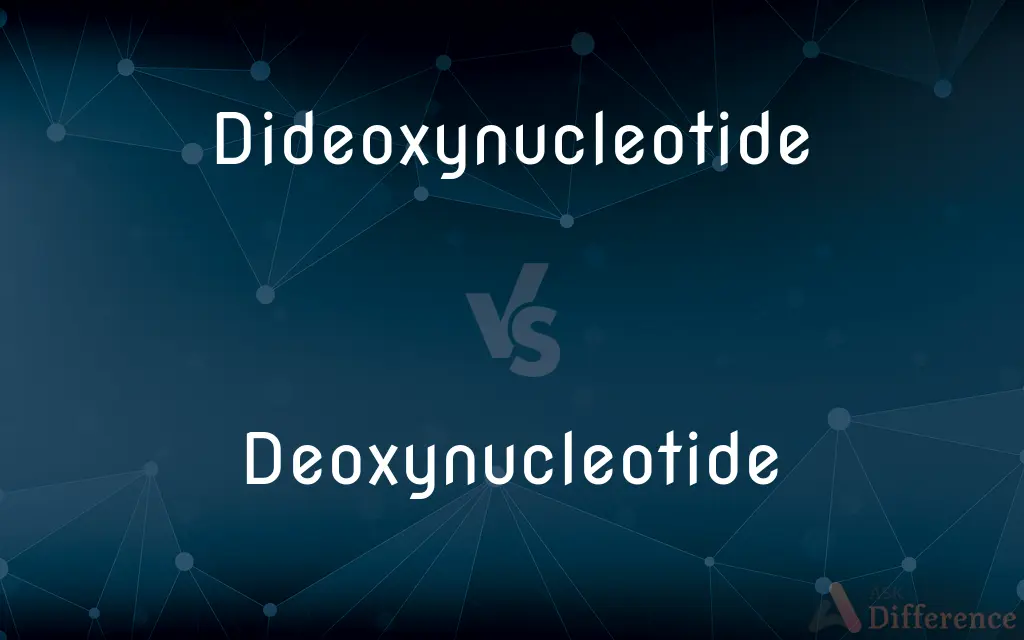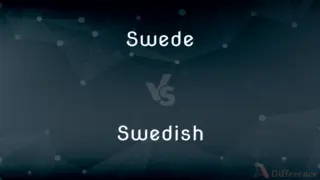Dideoxynucleotide vs. Deoxynucleotide — What's the Difference?
By Fiza Rafique & Maham Liaqat — Updated on April 3, 2024
Dideoxynucleotides are chain-terminating nucleotides used in DNA sequencing, lacking both 2' and 3' hydroxyl groups, while deoxynucleotides form the backbone of DNA, having a hydroxyl group only at the 3' position.

Difference Between Dideoxynucleotide and Deoxynucleotide
Table of Contents
ADVERTISEMENT
Key Differences
While ddNTPs are utilized in the lab for sequencing purposes to generate readable DNA fragments of varying lengths, dNTPs are found naturally in cells and are pivotal for the synthesis and maintenance of the genetic material. The use of ddNTPs in sequencing allows researchers to determine the sequence of nucleotides in a strand of DNA, which is fundamental for genetic analysis and biotechnological applications.
The presence or absence of specific hydroxyl groups in ddNTPs versus dNTPs not only defines their function but also their role in biotechnological applications, such as genetic engineering and forensic science. The precision with which ddNTPs can terminate DNA synthesis is crucial for the accuracy of DNA sequencing results.
In essence, the distinction between dideoxynucleotides and deoxynucleotides underscores the complexity of molecular biology and genetic engineering. While both are nucleotides, their structural differences impart them with unique roles in DNA synthesis, replication, and sequencing, highlighting the intricate mechanisms that underpin genetic information processing.
Comparison Chart
Hydroxyl Groups
Lacks both 2' and 3' hydroxyl groups
Has a hydroxyl group at the 3' position
Role in DNA
Terminates DNA chain elongation
Forms the backbone of DNA
ADVERTISEMENT
Use
DNA sequencing
DNA replication and repair
Presence in Nature
Synthetically made for lab use
Naturally occurring in cells
Contribution to Biotechnology
Essential for genetic analysis and sequencing
Fundamental for genetic material synthesis and maintenance
Compare with Definitions
Dideoxynucleotide
Chain terminator in DNA synthesis, preventing further elongation.
The incorporation of ddNTPs allows for the determination of the DNA sequence.
Deoxynucleotide
Present in the natural DNA synthesis and repair processes within cells.
DNA polymerase enzyme catalyzes the addition of dNTPs to the growing DNA strand.
Dideoxynucleotide
A synthetic nucleotide lacking both 2' and 3' hydroxyl groups, used in DNA sequencing.
In Sanger sequencing, each ddNTP terminates DNA synthesis at a specific base.
Deoxynucleotide
Essential for the formation of phosphodiester bonds between nucleotides.
The 3' hydroxyl group of a deoxynucleotide attacks the 5' phosphate group of another, forming a bond.
Dideoxynucleotide
Specifically designed for terminating the DNA chain in sequencing applications.
Scientists use ddNTPs to generate a series of terminated strands for sequence analysis.
Deoxynucleotide
A nucleotide with a hydroxyl group only at the 3' position, a building block of DNA.
Deoxynucleotides are added to a growing DNA strand during replication.
Dideoxynucleotide
Not present in natural DNA synthesis processes due to their inhibitory effect on chain elongation.
Dideoxynucleotides are laboratory-made molecules for specific scientific use.
Deoxynucleotide
Comprises the four types of nucleotides that encode genetic information.
The sequence of deoxynucleotides in DNA determines an organism's genetic blueprint.
Dideoxynucleotide
Integral to the process of determining the exact order of nucleotides within a DNA molecule.
Dideoxynucleotides are crucial for the success of the Sanger sequencing method.
Deoxynucleotide
Naturally occurring and constantly recycled within the cell.
Cells maintain a pool of dNTPs for DNA replication and repair.
Dideoxynucleotide
Dideoxynucleotides are chain-elongating inhibitors of DNA polymerase, used in the Sanger method for DNA sequencing. They are also known as 2',3' because both the 2' and 3' positions on the ribose lack hydroxyl groups, and are abbreviated as ddNTPs (ddGTP, ddATP, ddTTP and ddCTP).
Deoxynucleotide
Any nucleotide that contains a deoxy sugar
Dideoxynucleotide
(biochemistry) Any nucleotide formed from a deoxynucleotide by loss of a second hydroxy group from the deoxyribose group
Dideoxynucleotide
(biochemistry) Any oligonucleotide consisting of two deoxynucleotides
Common Curiosities
Are dideoxynucleotides found naturally in cells?
No, dideoxynucleotides are synthetically made for laboratory use, particularly in DNA sequencing.
What is the significance of the 3' hydroxyl group in deoxynucleotides?
The 3' hydroxyl group is critical for the elongation of DNA strands, as it forms the necessary bond with the incoming nucleotide's phosphate group.
Why can't dideoxynucleotides support the continuation of DNA synthesis?
They lack the 3' hydroxyl group necessary for forming the bond with the next nucleotide, thus terminating DNA synthesis when incorporated.
How do deoxynucleotides contribute to DNA structure?
Deoxynucleotides form the backbone of DNA, contributing to its structure by linking together via phosphodiester bonds.
What are dideoxynucleotides used for?
Dideoxynucleotides are used in DNA sequencing methods to terminate the elongation of DNA strands at specific nucleotides.
How do deoxynucleotides and dideoxynucleotides differ in structure?
Dideoxynucleotides lack both 2' and 3' hydroxyl groups, whereas deoxynucleotides have a hydroxyl group at the 3' position only.
How are dideoxynucleotides critical to DNA sequencing?
By terminating DNA synthesis at specific points, they enable the determination of the sequence of nucleotides in DNA.
Can dideoxynucleotides be used in DNA replication?
No, because they terminate DNA synthesis upon incorporation, they are not suitable for processes that require continuous DNA elongation, like replication.
What roles do deoxynucleotides play in the cell?
They are the building blocks of DNA, necessary for replication, repair, and the transmission of genetic information.
Are there any natural sources of dideoxynucleotides?
No, dideoxynucleotides are exclusively synthesized for scientific and biotechnological applications.
Share Your Discovery

Previous Comparison
Swede vs. Swedish
Next Comparison
Claw vs. PawAuthor Spotlight
Written by
Fiza RafiqueFiza Rafique is a skilled content writer at AskDifference.com, where she meticulously refines and enhances written pieces. Drawing from her vast editorial expertise, Fiza ensures clarity, accuracy, and precision in every article. Passionate about language, she continually seeks to elevate the quality of content for readers worldwide.
Co-written by
Maham Liaqat















































